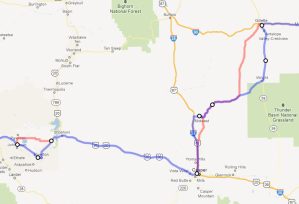On the whole, Google Maps is a great service. The interface is clean, ads are unobtrusive, performance is generally very good, and its ability to parse abbreviations and incomplete names is top-notch. But after a spate of less than ideal driving directions from Google, I decided to step back and look at some of the other popular online mapping services to see if any competitors offered higher quality directions or a better experience.
I’ll touch on a number of services in upcoming posts, but first, some background on my recent experiences with Google Maps that spurred this comparison.
Go-go Gadget Map
Sometimes Google’s driving directions appear to favor minuscule improvements in distance or speed over more sensible directions, e.g. a number of small turns on side streets saving 0.1 mile or less, rather than reducing the number of turns or continuing on a single arterial road. Perhaps Google assumes that your smartphone or sat-nav gadget is holding your hand the whole way and thus it doesn’t much matter if the directions make more sense to robots than to humans. [1]
That choice, however, leads to some odd directions. For example, when heading southbound on the Berlin Turnpike (US-5/CT-15), just south of the CT-9 overpass there is a turnout to the right which loops around to cross the Turnpike perpendicularly to allow for an easier left turn across traffic. However, when heading southbound without needing a left turn, Google Maps still suggested taking this turnout and then merging back on the Turnpike in the original direction of travel. [2] This diversion may have saved a few feet at best (though even that seems doubtful) at the expense of adding two entirely needless steps to the directions.
Or in Oregon City, Oregon, when traveling southwest from Washington Street onto Center Street. The Google directions suggest a slight diversion onto 8th St (a minor sidestreet) rather than continuing on Washington St until 7th Street (a sizable throughway). Google’s own color-coding shows Washington, 7th, and Center streets in yellow and 8th Street in white, indicating that 8th St is a comparatively minor road, but still suggests the 8th St route due to the route being 1 metre shorter. [3]
A potentially more dangerous tendency of Google Maps is to consider distance and time traveled more heavily than road type and remoteness. When driving from Rapid City, South Dakota, to Jackson, Wyoming, Google suggests taking WY-50 over WY-59, WY-259 over continuing on WY-387, and WY-134 to WY-133 over continuing on US-26. In all of these cases, Google’s directions favor roads which are considered by AAA to be “local” over “through” roads. [4] Opting for alternatives to Google’s suggested roads does increase travel time and distance (by a measly 19 minutes and 24 km on a 9+ hour drive), but in remote stretches such as these, a slight increase in travel time is well worth it if the road is poorly maintained, there are no gas stations on the lesser-trod road, or the local roads are sparsely signed.

So, it looks like Google’s directions could use a few improvements. [5] So let’s see what else is out there …
(Continued in part 2)
- Indeed, while drafting this post a BBC News item about Google and robot cars popped up in my news reader.
- This particularly odd suggestion appears to have been corrected in the interim since my original query a few months back.
- Yes, a difference of less than 40 inches.
- I’m not from eastern Wyoming, but AAA’s “local” and “through” labels seemed appropriate to my own eyes as I drove through the area.
- Google’s unique features and capabilities will be covered in a follow-up post after all of the other services have been picked apart.

